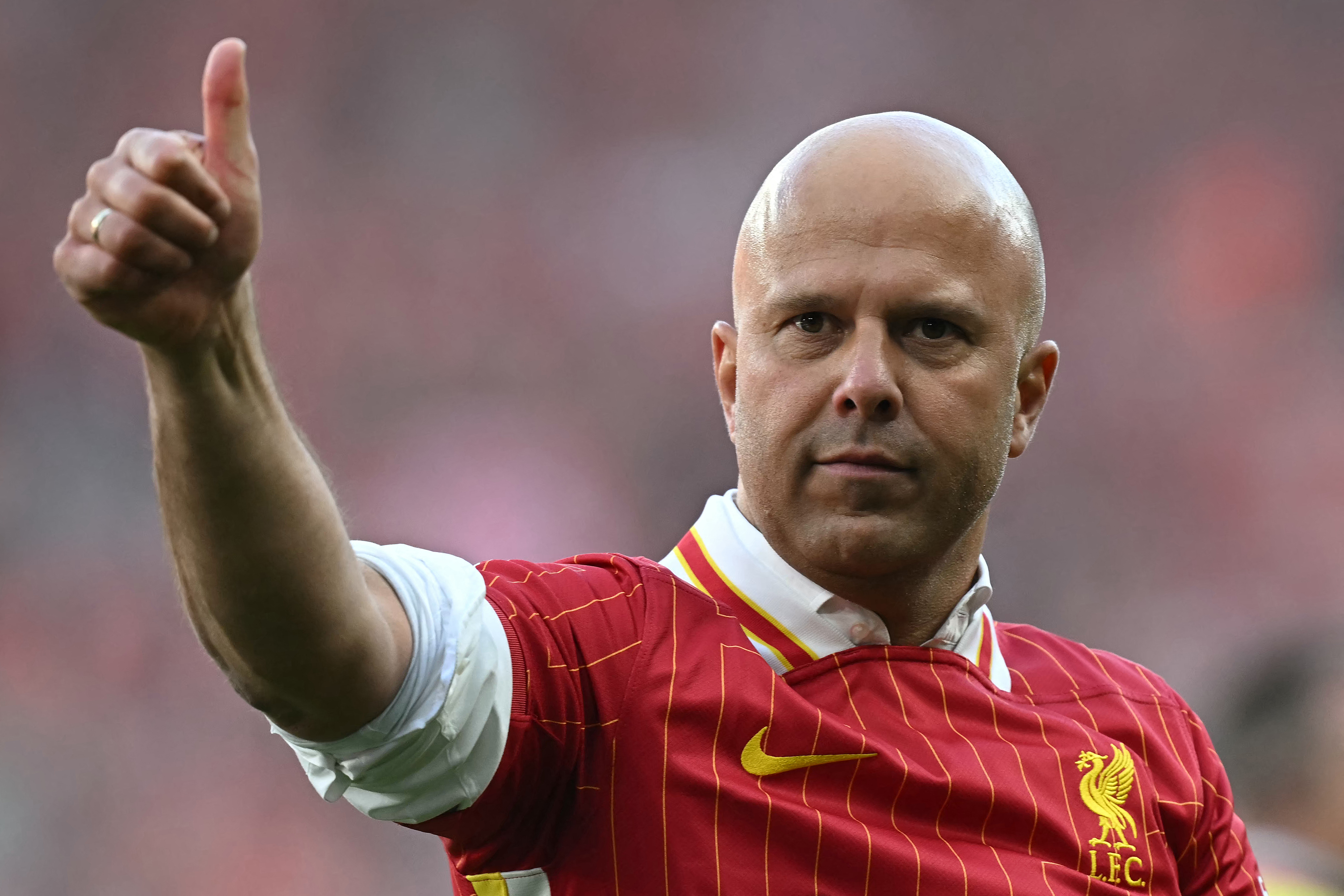4 talking points from Chelsea 3-0 Burnley: is Hazard really back to his best?
Seb Stafford-Bloor was at Stamford Bridge using Stats Zone as Antonio Conte's men eased past Burnley
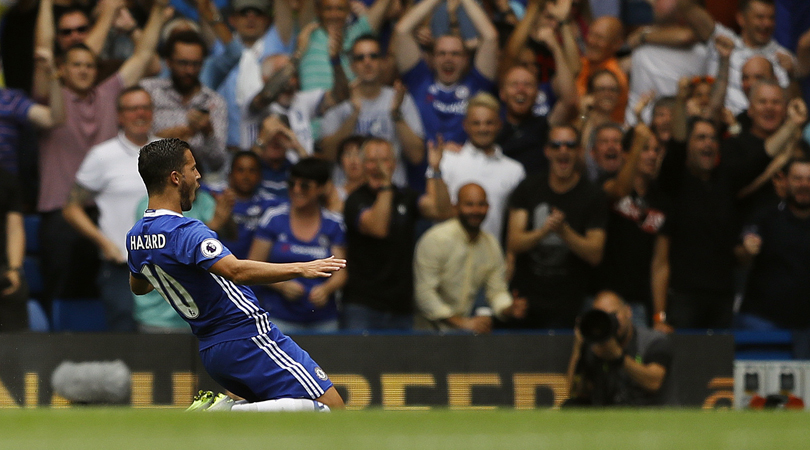
1. This was Hazard at his very best
With what's now known about the background factors at Chelsea last season, it's difficult to fully explain Eden Hazard's malaise. The Belgian, such a dynamic and deserving PFA Player of the Year in 2014/15, sank into perma-stasis. Ponderous and too quick to relinquish attacking responsibility, he was far too often a peripheral figure in games he would previously have dominated.
2016/17 has begun completely differently. Looking remarkably fresh for a player who took part in Euro 2016, Hazard decimated Burnley's right side. Antonio Conte's 4-2-4 may initially place the Belgian tight to the touchline, but it affords far more space than Jose Mourinho's equivalent and allows him to touch the ball in more dangerous positions.
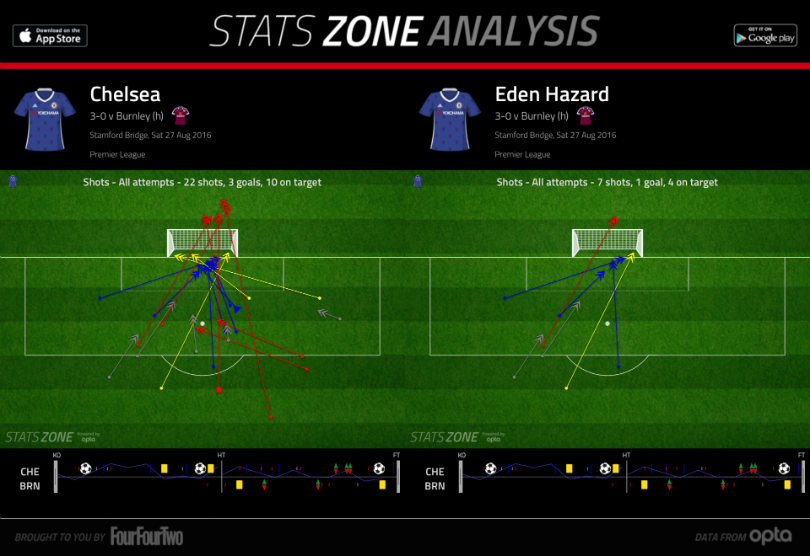
By half-time at Stamford Bridge, in addition to scoring the game's opening goal, Hazard had completed 22 of 27 attacking passes, seven more than any other player. By the time of his eventual withdrawal after 82 minutes, that had risen to 38 from 45. There were flourishes – and one highly unnecessary rabona – but this was Hazard at his undiluted best; as a pronounced individual talent, but one which is now being finessed into a complementary system.
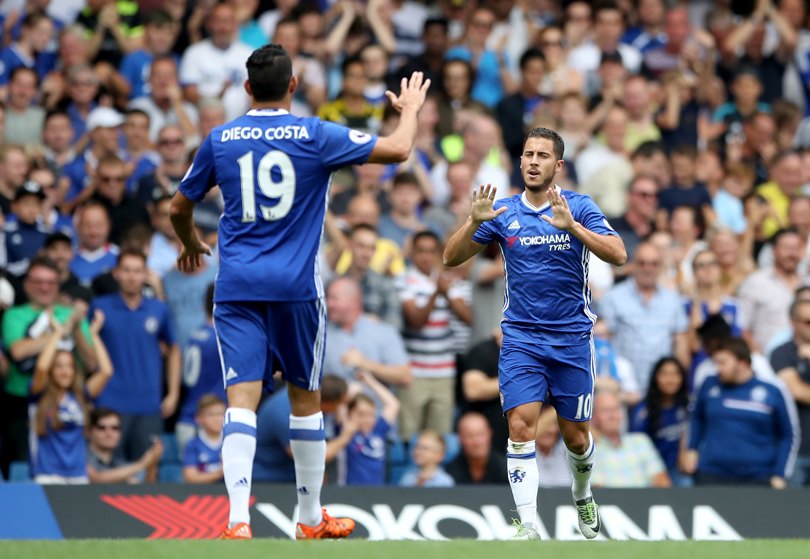
Quite appropriately, too, because he is a force which needs to be channelled correctly. Conte spoke in his press conference about the importance of the collective – or "family" – and that's particularly relevant to his winger. The Belgian needs the right conditions to thrive – to receive the ball quickly, to have options ahead of ahead of him – and these initial signs, ominously, suggest that his surroundings are finally right again.
2. Conte prioritises width to good effect
Conte is a highly animated touchline presence and, at times, he is more puppeteer than coach. He prowled the perimeter of his technical area for the full 90 minutes against Burnley and the flow of directions and instructions was relentless; the Italian wanted width and he wanted it all the time.
Get FourFourTwo Newsletter
The best features, fun and footballing quizzes, straight to your inbox every week.
A feature of this new Chelsea is that, even when the nominal wingers drift infield, another player – be it Diego Costa, Oscar, or an advancing full-back – will typically drift wide. Maybe a tougher opponent will be needed for a proper examination of that system's strengths and vulnerabilities, but against a Burnley team determined to defend with two flat banks of four, it inevitably created all manner of half-spaces into which Conte's playmakers obligingly danced.
Sean Dyche's side were not at their best and, in fairness, their Premier League survival won't depend on winning points against such powerful teams, but the ease with which they were maneuvered into short-handed situations was alarming. Even when defending deep and protecting their box's perimeter, Burnley were forced to recover lost ground on spare men and belatedly track players who had snuck between the lines.
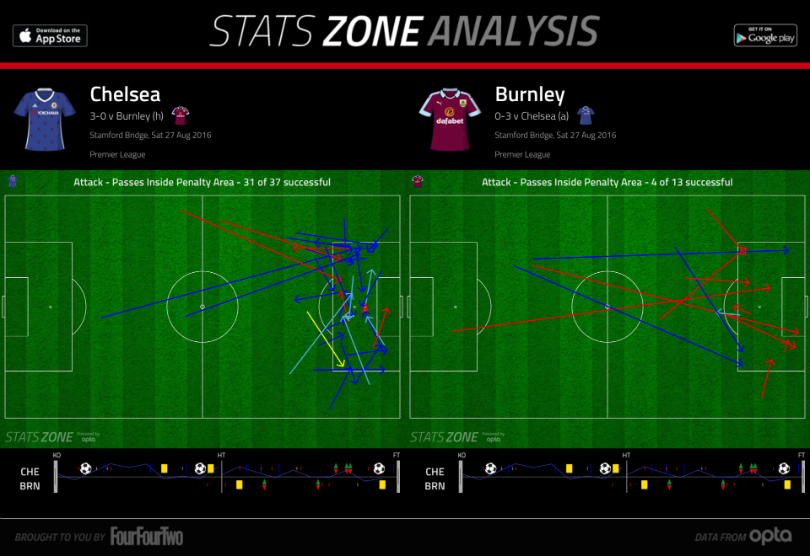
Chelsea's intricacy – and general talent level – helped to make that possible, but the width with which they played on Saturday and the maniacal manner in which Conte governed that shape accentuated the distance between the two teams. The hosts completed 190 passes in the attacking third which is telling, but they also managed 31 inside the penalty box and that was highly illustrative of their ability to penetrate a cautious, deep-lying opponent.
3. Nemanja Matic vs Cesc Fabregas
Matic was a curious selection. Conte's 4-2-4 naturally places a greater emphasis on the defensive qualities of his 'two', but N'Golo Kante's holding abilities probably would have been sufficient. Matic's decline hasn't perhaps been as pronounced as commonly claimed, but he was still a restrictive presence on Saturday. He may have provided an extra layer of solidity, but his one-dimensional passing was a limitation – and will be more so against sides who exert greater pressure in the midfield.
His tendency – as it was against Burnley – is to play high-percentages balls or push possession to a flank when, for the sake of maintaining the temperament which fuels their chance creation, Chelsea require distribution from that area which moves them up the field with greater urgency.
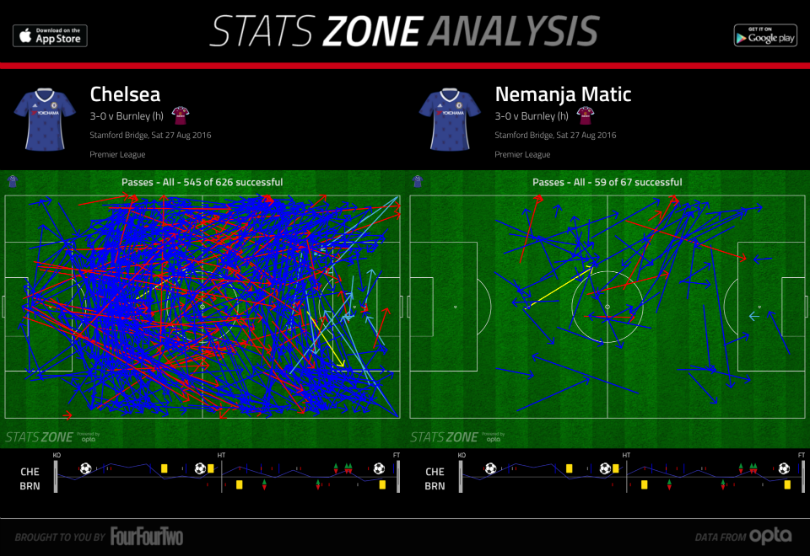
This will be a lasting issue. Cesc Fabregas's impact at Watford a week ago, in the 12 minutes after replacing Matic, showed what the alternative looks like and one of Conte's initial tests will be to manage his midfield's chemistry. Matic may have ultimately sprung Hazard for the opening goal, but he and Fabregas remain opposing elements: stopper versus animator, protection versus temperament.
4. Burnley shouldn't worry about going basic
What to make of Burnley in a context which, for all intents and purposes, was irrelevant. They came to Stamford Bridge to be compact and to make Chelsea work for their lead and, unfortunately, that gameplan was invalidated by Hazard's early goal.
One detail, though: they shouldn't be afraid of being more direct. Dyche's prides himself on not being a long-ball manager and in raging against the stereotypes which are used to flog English coaches. That's admirable but, against Chelsea's lightning-quick counter-attacks, it was flawed. Though the first goal owed much to Hazard's brilliance and his ability to punish slight lapses, it was still essentially a self-inflicted wound: Andre Gray's loose touch surrendered possession, Burnley were caught out of position, and Hazard surged through. It was a brutally punitive tax on trying to play too much football.
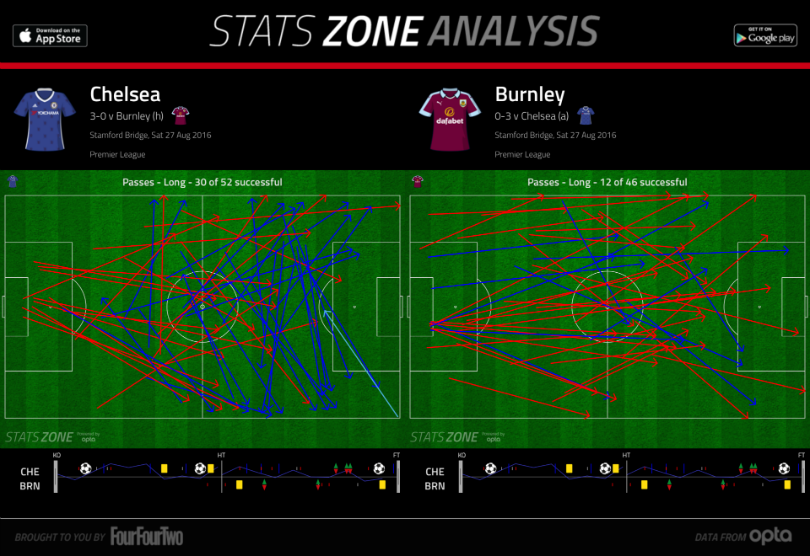
Sam Vokes is a static forward but Gray is highly mobile, begging the question as to why – in exiting from their own zones – Burnley were so reticent in targeting the wide channels at the top of the pitch. Perversely, when they did employ long balls, they were typically aimed straight down the centre of the pitch. Neither John Terry nor Gary Cahill are known for their mobility and so Burnley's best opportunity to relieve pressure on their overworked defence might have been to push them into unfamiliar areas. It's a balance, of course, and exit strategies need to blend ball retention and self-preservation, but it's one the visitors didn't manage to find.
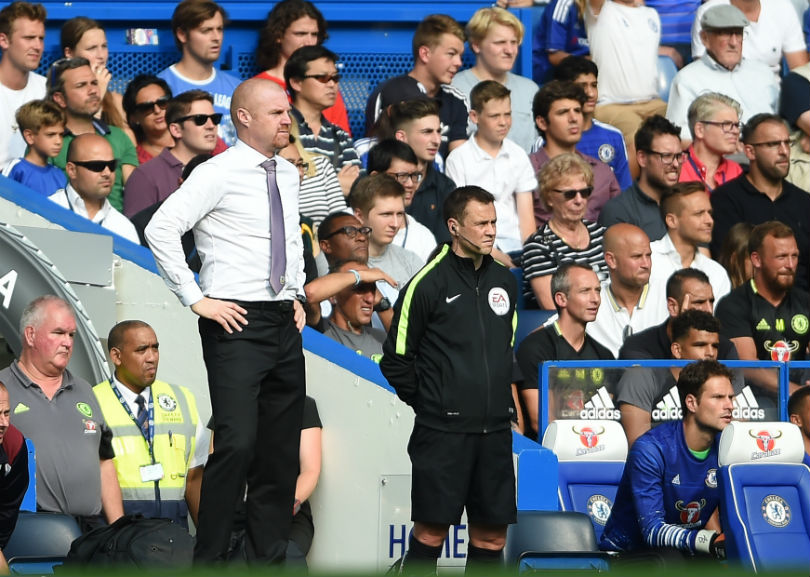
Dyche's philosophies are to be applauded and, even if not apparent on Saturday, he has built a fundamentally sound football team. However, aside from a chastening dose of reality, they'll take a valuable lesson from Stamford Bridge: being situationally smart is more valuable than any style points. A week ago, they beat Liverpool having made just 218 passes. On Saturday that number rose to 300, but also brought with it a new set of vulnerabilities. Possession has to be situationally smart.
Match facts
- Eden Hazard has scored 6 goals in his last 8 Premier League games, having scored 6 in 44 games prior to that.
- Antonio Conte is now unbeaten in his last 30 home league matches as a manager (W28 D2).
- Diego Costa has had a hand in a goal in each of his last 5 Premier League appearances (3 goals, 2 assists).
- The Clarets conceded more goals in this game (3) than they had in their previous 4 away Premier League games (2).
- The Blues ended a run of 13 home Premier League games without a clean sheet, with their last before today in a 2-0 win over Norwich in November 2015.
- Victor Moses scored his first Premier League goal for Chelsea since November 2012.
- Burnley’s first shot in this game was in the 43rd minute.
- The Clarets still haven’t won at Stamford Bridge since April 1971, losing 6 and drawing 2 games since then.
STATS ZONE Free on iOS • Free on Android
Seb Stafford-Bloor is a football writer at Tifo Football and member of the Football Writers' Association. He was formerly a regularly columnist for the FourFourTwo website, covering all aspects of the game, including tactical analysis, reaction pieces, longer-term trends and critiquing the increasingly shady business of football's financial side and authorities' decision-making.
